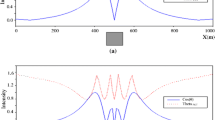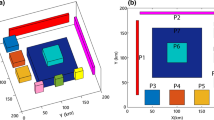Abstract
Image processing techniques have been frequently used in processing of potential field data. The most important aim in processing potential field data is to figure out the edges of the geological bodies. The Gabor filter was used to determine the discontinuity boundaries of the source bodies causing the magnetic anomalies in this study. The synthetic total magnetic anomaly of three prism bodies with different depths and orientations was used to test the effect of the Gabor filter on the magnetic data. In addition, the Gabor filter was applied on the reduction to the pole aeromagnetic field data of the Marmara Sea and the results were compared with the fault distribution map of the area prepared by various authors.








Similar content being viewed by others
References
Adatepe, F.M., 1991. Interpretation of gravity and magnetic data Marmara Sea using Fourier transforms. Jeofizik 5, 127-133 (in Turkish).
Ates, A., Bilim, F., Buyuksarac, A., Bektas, O., 2008. A tectonic interpretation of the Marmara Sea. NW Turkey from geophysical data. Earth Planet Space 60, 169-177.
Baranov, V., 1957. A new method for interpretation of aeromagnetic maps: pseudo gravimetric anomalies. Geophysics 22, 359-383.
Clark, M., Bovik, A. C., Geisler, W. S., 1987. Texture segmentation using a class of narrowband filters. Proceedings of Int. Conf. Acoustics, Speech, Signal Processing, 571-574.
Cordell, L., 1979. Gravimetric expression of graben faulting in Santa Fe country and the espanola basin, New Mexico. In: Ingersoll, R.V., (Ed.), Guidebook to Santa Fe country: New Mexico Geol. Soc. Guidebook. 30th Field Conference, 59-64.
Daugman, J. G., 1985. Uncertainty relation for resolution in space, spatial frequency, and orientation optimized by two-dimensional visual cortical filters. Journal of the Optical Society of America A 2, 1160-1169.
Daughman, J.G., 1988. Complete discrete 2-D Gabor transforms by neural networks for image analysis and compression. IEEE Trans. Acoust. Speech Signal Processing 36, 1169-1179.
Ergün, M., 1977. Magnetic studies in Cyprus and the Biga peninsula, Turkey. Ph.D. thesis, University of Leicester, England.
Mehrotra, R., Namuduri, K. R., Ranganathan, N., 1992. Gabor filter-based edge detection. Pattern Recognition 25, 1479-1494.
Miller, H. G.., and Singh, V., 1994. Potential field tilt-a new concept for location of potential field sources: Journal of Applied Geophysics 32, 213-217.
Prewitt, J., 1970. Object Enhancement And Extraction, Picture Processing and Psychopictorics (B. Lipkin and A. Rosenfeld, Ed.), NY, Academic Pres.
Roberts, L. G., 1965. Machine Perception of Three-Dimensional Solids, in optical and Electro-Optical Information Processing (J. Tippett, Ed.), 159-197, MIT Pres.
Sobel, I., 1970. Camera Models and Perception, Ph.D. thesis, Stanford University, Stanford, CA.
Sobel, I., 1990 An Isotropic 3 × 3 Gradient Operator, Machine Vision for Three-Dimensional Scenes, Freeman, H., Academic Pres, NY, 376-379.
Verduzco, B., Fairhead, J. D., and Green, C. M., and Mackenzie, C. 2004. The meter reader-new insights into magnetic derivatives for structural mapping: The Leading Edge 23, 116-119.
Yang, J., Liu, L., Jiang, T., Fan, Y., 2003. A modified Gabor filter design method for fingerprint image enhancement. Pattern Recognition Letters 24, 1805-1817
Zhou, D., Wang, W. Y., Wang, J. L., Pang, X., Cai, D. S., and Sun, Z., 2006. Mesozoic subduction-accretion zone in northeastern South China Sea inferred from geophysical interpretations: Science in China: Science in China Series D: Earth Sciences 49, 471-482.
Acknowledgments
We thank the Mineral Research and Exploration General Directorate for permission to use the magnetic data in Fig. 6. We thank also Pierre Keating (Editor) and anonymous reviewers for their constructive comments on the manuscript.
Author information
Authors and Affiliations
Corresponding author
Rights and permissions
About this article
Cite this article
Sertcelik, I., Kafadar, O. & Kurtulus, C. Use of the Two Dimensional Gabor Filter to Interpret Magnetic Data Over the Marmara Sea, Turkey. Pure Appl. Geophys. 170, 887–894 (2013). https://doi.org/10.1007/s00024-012-0587-0
Received:
Revised:
Accepted:
Published:
Issue Date:
DOI: https://doi.org/10.1007/s00024-012-0587-0




